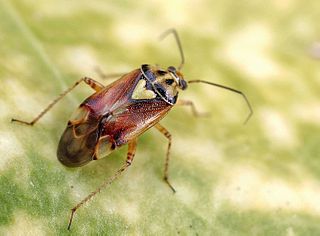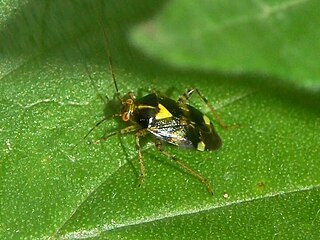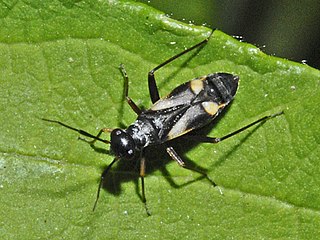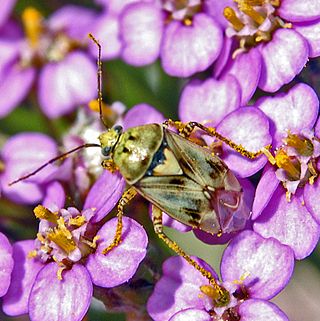
The Miridae are a large and diverse insect family at one time known by the taxonomic synonym Capsidae. Species in the family may be referred to as capsid bugs or "mirid bugs". Common names include plant bugs, leaf bugs, and grass bugs. It is the largest family of true bugs belonging to the suborder Heteroptera; it includes over 10,000 known species, and new ones are being described constantly. Most widely known mirids are species that are notorious agricultural pests that pierce plant tissues, feed on the sap, and sometimes transmit viral plant diseases. Some species however, are predatory.

The genus Lygus includes over 40 species of plant-feeding insects in the family Miridae. The term lygus bug is used for any member of genus Lygus.

The tarnished plant bug (TPB), Lygus lineolaris, is a species of plant-feeding insect in the family Miridae. It has piercing-sucking mouthparts and has become a serious pest on small fruits and vegetables in North America. It is considered a highly polyphagous species and feeds on over half of all commercially grown crop plants, but favors cotton, alfalfa, beans, stone fruits, and conifer seedlings. A study done in southwestern Quebec, Canada has investigated the presence of L. lineolaris in a commercial vineyard. This study also indicated that weeds that grow from cultivation of crops serve as an important food source for L. lineolaris. This insect can be found across North America, from northern Canada to southern Mexico. Adults grow up to 6.5 mm in length, and are brown with accents of yellow, orange or red, with a light-colored "V" on the back (dorsal). The genome has recently been sequenced for the first time.
A trap crop is a plant that attracts agricultural pests, usually insects, away from nearby crops. This form of companion planting can save the main crop from decimation by pests without the use of pesticides.[1] A trap crop is used for attracting the insect and pests away from the field.[1] Many trap crops have successfully diverted pests from focal crops in small scale greenhouse, garden and field experiments; a small portion of these plants have been shown to reduce pest damage at larger commercial scales. A common explanation for reported trap cropping failures, is that attractive trap plants only protect nearby plants if the insects do not move back into the main crop. In a review of 100 trap cropping examples in 2006, only 10 trap crops were classified as successful at a commercial scale, and in all successful cases, trap cropping was supplemented with management practices that specifically limited insect dispersal from the trap crop back into the main crop.

Capsodes flavomarginatus is a species of plant bug belonging to the family Miridae, subfamily Mirinae.

Deraeocoris schach is a species of plant bugs belonging to the family Miridae, subfamily Deraeocorinae.

Liocoris tripustulatus or the common nettle bug is a species of plant bug belonging to the family Miridae, subfamily Mirinae. The species was first described by Johan Christian Fabricius in 1781.

Lygus pratensis is a species of plant bug belonging to the family Miridae.

Myopa dorsalis is a species belonging to the family Conopidae subfamily Myopinae.
Peristenus pseudopallipes is a parasitoid, which lives within a host as part of its life cycle. It then emerges from the host organism, killing the host.
Adelphocoris rapidus, common names for which are rapid plant bug or superb plant bug, is a species of Hemiptera in the family Miridae, that can be found everywhere in the United States, and in the Peace–Athabasca Delta, Canada. The species are larger than other members of the family, and are either yellowish-black or orange-black coloured.

Heterotoma planicornis is a species of bug from Miridae family.

Closterotomus biclavatus is a plant bug belonging to the family Miridae, subfamily Mirinae. The species was first described by Gottlieb August Wilhelm Herrich-Schäffer in 1835.

Lygus wagneri is a species of plant bug belonging to the family Miridae, subfamily Mirinae.

Orthonotus rufifrons is a species of plant bugs belonging to the family Miridae.

Globiceps fulvicollis is a species of plant-feeding insect of the family Miridae.

Taylorilygus apicalis or broken-backed bug is a species of plant bug in the family Miridae.

Lygus gemellatus is a species of plant-feeding insects in the family Miridae.

Plagiognathus arbustorum is a species of insects in the family Miridae, the plant bugs.

Lygus punctatus is a species of plant bug in the family Miridae.


















